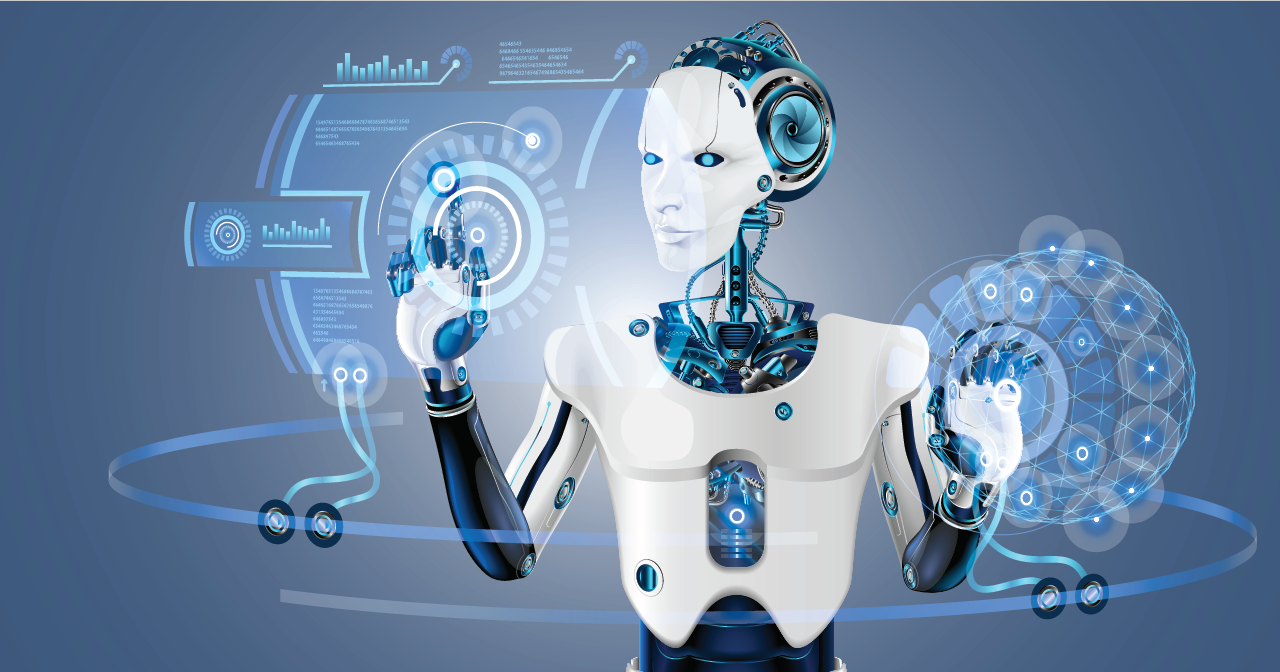
AI in Tech: From Buzzword to Business Backbone
AI in Tech: From Buzzword to Business Security Strategy
The AI landscape is often a whirlwind of hype, with new terms and capabilities emerging daily. But beneath the buzz, a more profound transformation is taking place – one where AI is quietly integrating into the fabric of business operations, delivering tangible improvements.
AI in tech has transformed from a mere buzzword into a foundational technology, moving from marketing hype to a business necessity for efficiency and growth. This evolution is marked by the development of advanced AI technologies, such as Generative AI, which creates content, and Agentic AI, which performs tasks, increasingly serving as the backbone of companies by driving tangible outcomes and integrating into daily business operations.
From Hype to Reality
Shifting Perceptions:
AI started as a trendy term but has now become a strategic business tool, with a significant number of CEOs investing in it to enhance organizational efficiency.
Workforce Transformation
- Shadow AI: Organizations face a new challenge as employees deploy personal AI agents to automate tasks without official oversight, raising security and compliance concerns
- AI Governance: Companies are creating dedicated roles to manage AI implementation and mitigate risks, responding to high-profile AI-related incidents
- The Great Talent Flip: Engineering talent is pivoting from AI model optimization to product development, creating retention challenges
- Startup AI Teams: The traditional engineering-heavy startup model is inverting, with teams now comprising 80% product specialists and 20% engineers. AI helps with the “how” which traditionally falls on engineering.
A.I. Buzzwords: Top Artificial Intelligence Changes Reshaping Business
At Risk Cognizance, based right here in New York, we're not just observing this shift; we're actively facilitating it. We believe the true power of AI lies not in its ability to generate headlines, but in its capacity to become an indispensable, "quiet utility" that drives real value.
So, how do we bridge the gap between AI's potential and its practical application in improving business? Here’s how we’ve seen that happen, transforming abstract concepts into concrete solutions for our clients:
- Document Intelligence → Semantic search, OCR, RAG pipelines
- Customer Personalization → AI GRC insights, recommendation models
- Smarter Decisions → Real-time analytics, risk management optimization
- Agentic AI → Tools for AI Policy Linker, IA Risk Management, AI Framework Mapping and internal workflows expansion, identifying other areas where Risk Cognizance can utilize AI.
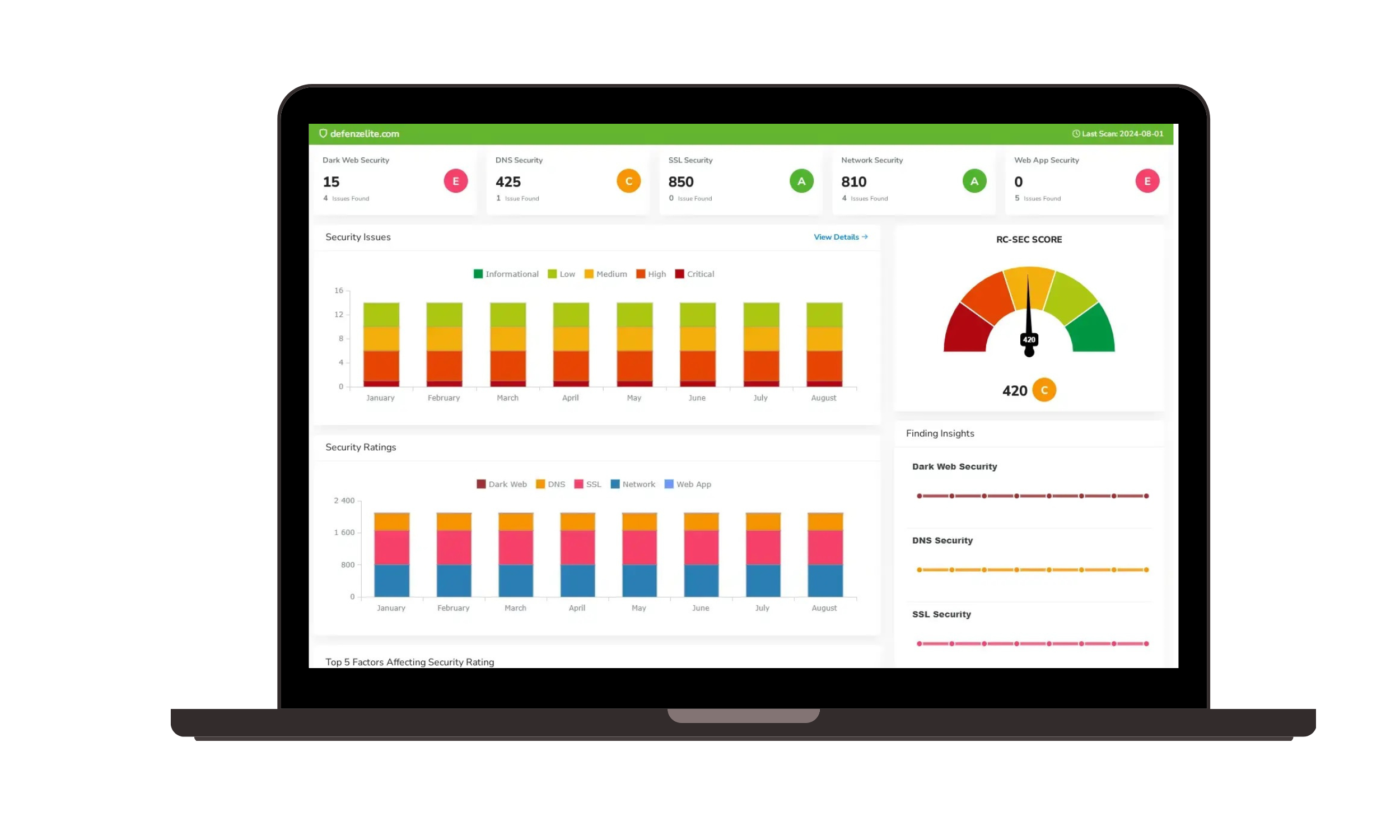
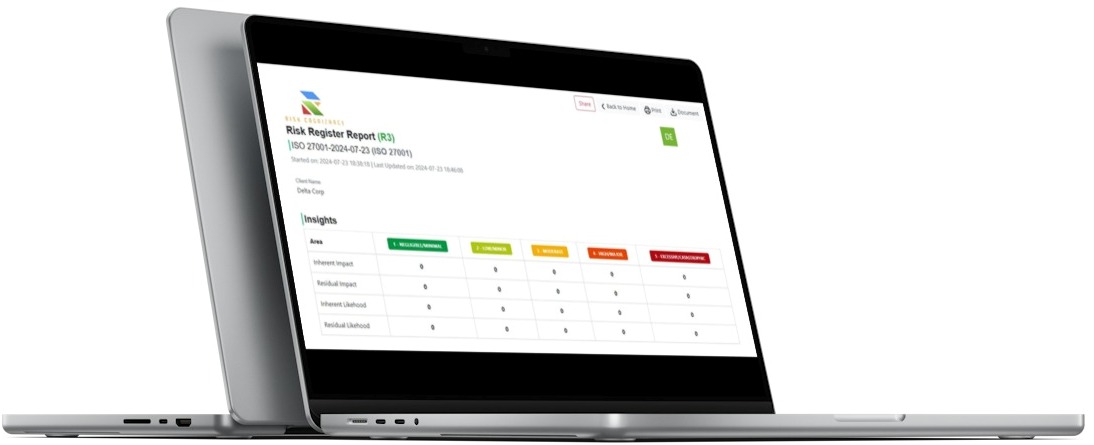
Why Risk Cognizance?
Risk Cognizance is a leader in using AI to provide a holistic approach to Governance, Risk, and Compliance (GRC). We help organizations anticipate risks, safeguard their reputation, and enhance performance through our proactive and comprehensive enterprise risk management (ERM) software. Our AI-powered platform stands out for its robust, all-in-one features that simplify complex regulatory requirements and security risks. We don't just offer tools; we provide a complete solution that includes continuous threat exposure management, brand risk management, and vendor risk cognizance, ensuring your business stays secure and compliant.
What Are Actionable Insights?
Actionable insights are meaningful, data-driven findings that not only tell you what is happening but also why it's happening and what you should do next. Unlike a simple data report that presents numbers and charts, an actionable insight provides a clear, specific, and timely recommendation that can be used to make a positive change in the business. For example, instead of just showing that sales are down, an actionable insight might reveal that a specific product's sales are declining because of negative social media reviews and recommend a targeted marketing campaign to address the issue.
What is an AI Agent?
An AI agent is an autonomous software system that uses AI to achieve a pre-determined goal on behalf of a user. Unlike traditional programs that follow a set of rigid rules, an AI agent can reason, plan, make decisions, and even learn and adapt to its environment. They can perform complex, multi-step tasks with a high degree of autonomy, making them more than just simple bots or assistants.
What is an Agentic Platform?
An agentic platform is a system designed to create and orchestrate multiple, specialized AI agents to work together towards a larger organizational outcome. It's not just about a single AI agent doing one thing; it's about a coordinated network of agents that can communicate, share information, and manage complex workflows. These platforms prioritize business outcomes, often reducing the need for direct human oversight for routine tasks, allowing people to focus on strategic work. An agentic platform can integrate with various systems, use multiple types of machine learning, and adapt to changing conditions to achieve its goals.
Is Risk Cognizance an Agentic Platform?
Yes, Risk Cognizance is an agentic platform. While not all of its features are "agentic," its core design philosophy and many of its advanced capabilities align with the concept of an agentic platform. The platform uses AI agents to continuously monitor and assess risks, map compliance frameworks, and automate evidence collection. This goes beyond simple automation—it's about an intelligent system working autonomously to achieve the outcome of a secure, compliant, and well-governed organization. The platform's ability to orchestrate these various functions, from risk assessment to real-time monitoring, demonstrates its agentic nature.
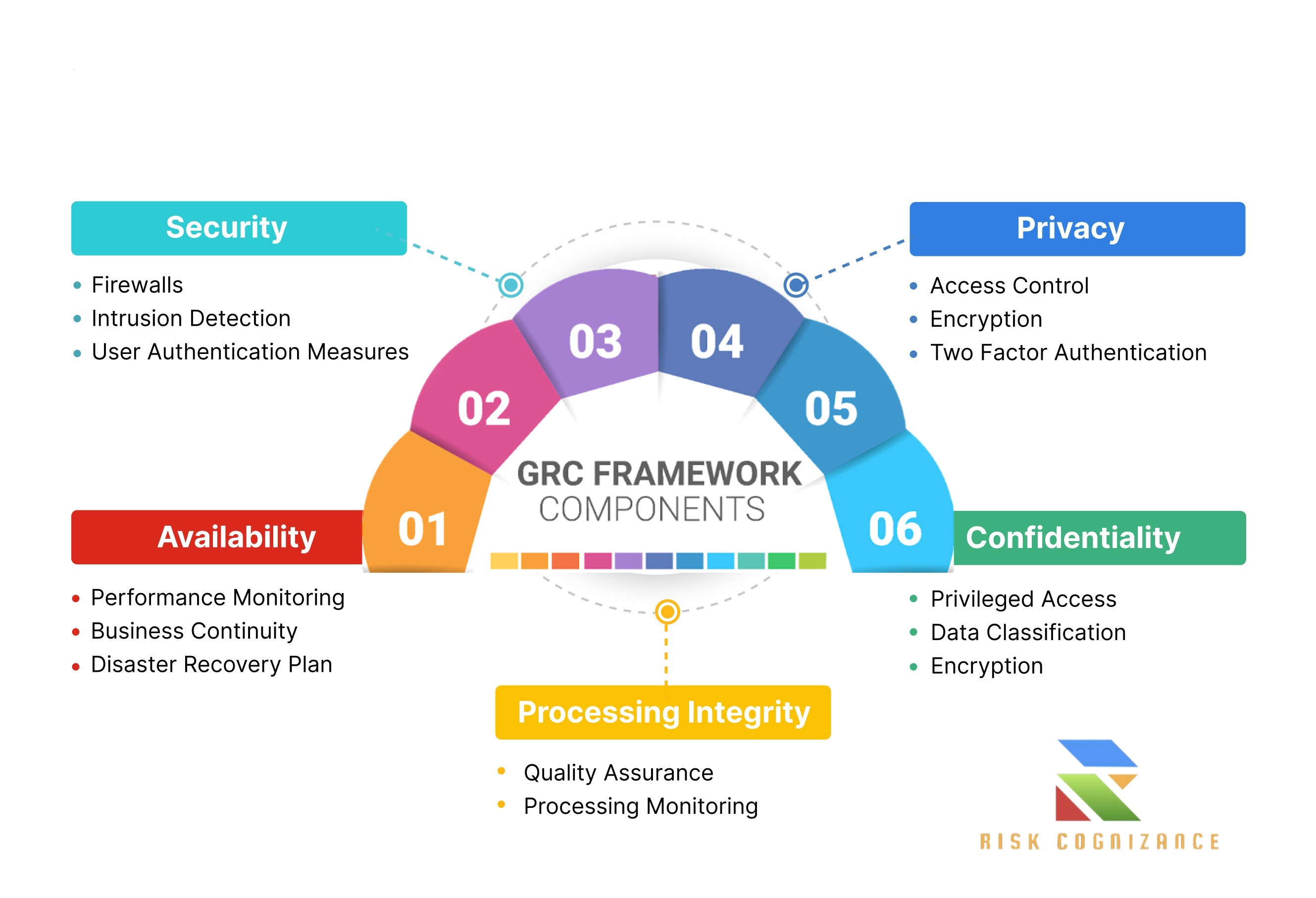
Top 10 FAQs about AI at Risk Cognizance
How is AI used in risk management? AI analyzes vast datasets to identify and predict potential risks, automates routine compliance tasks, and provides real-time insights to help organizations make proactive decisions.
- Is my data safe with your AI platform? We use robust security protocols, including encryption and strict access controls, to protect your sensitive data. Our AI models are designed with privacy and compliance in mind.
- How does your AI platform ensure compliance? Our AI maps controls across multiple regulatory frameworks, automates evidence collection, and continuously monitors for deviations, ensuring you stay compliant with standards like NIST, ISO, and GDPR.
- Can your AI platform work with my existing systems? Yes, our platform is designed for seamless integration with various third-party systems, including GRC software, CRMs, and other enterprise tools.
- How do you prevent AI bias in your models? We use rigorous data validation and testing processes to identify and mitigate bias. Our models are continuously audited to ensure fairness and accuracy.
- Is human oversight still necessary with AI? Absolutely. AI is a powerful tool for augmentation, not replacement. Human expertise is crucial for strategic decision-making, interpreting complex insights, and providing ethical oversight.
- How quickly can we see a return on investment (ROI)? Our clients often see a rapid ROI through increased efficiency, reduced compliance costs, and proactive risk mitigation that prevents costly incidents.
- What's the difference between your AI and a chatbot? Our AI goes far beyond a simple conversational interface. It's a proactive system that can perform complex tasks, analyze data, and manage entire workflows autonomously.
- How does your AI help with third-party risk management? Our AI agents assess vendor risks, monitor their compliance status, and provide a real-time risk rating, streamlining the due diligence process.
- How does your AI platform help with brand risk? Our platform uses AI to monitor the dark web, social media, and other digital channels to detect threats like phishing, counterfeit applications, and brand impersonation before they cause significant damage.
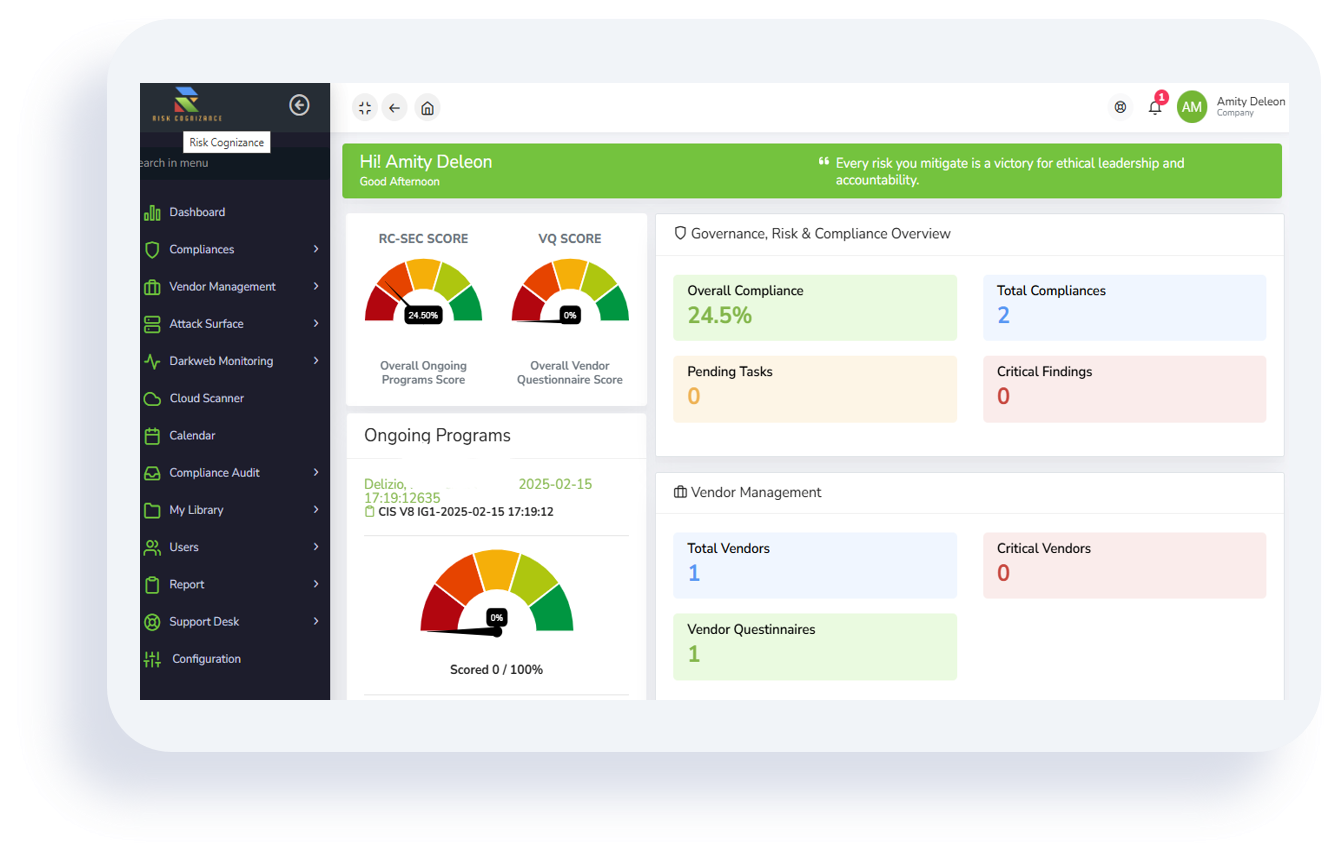
5 Key Use Cases for Risk Cognizance’s AI Platform
- Cybersecurity Risk Assessment: The platform uses AI to continuously scan an organization's attack surface, identify vulnerabilities, and prioritize remediation efforts based on the potential business impact.
- Automated Compliance Audits: AI agents automatically collect and organize evidence from various systems, map it to specific compliance controls, and generate audit reports, dramatically reducing the time and effort required for GRC audits.
- Real-Time Vendor Risk Monitoring: Instead of static annual assessments, our AI provides a continuous risk score for third-party vendors by monitoring for security incidents, data breaches, and other reputational threats in real-time.
- Proactive Financial Risk Management: The platform analyzes financial data, market trends, and economic indicators to predict potential financial risks, such as credit defaults or supply chain disruptions, allowing for proactive mitigation.
- Agentic Internal Workflows: The AI platform can autonomously manage internal GRC workflows, from assigning risk mitigation tasks to the relevant teams to automatically escalating issues that exceed a pre-defined risk threshold.
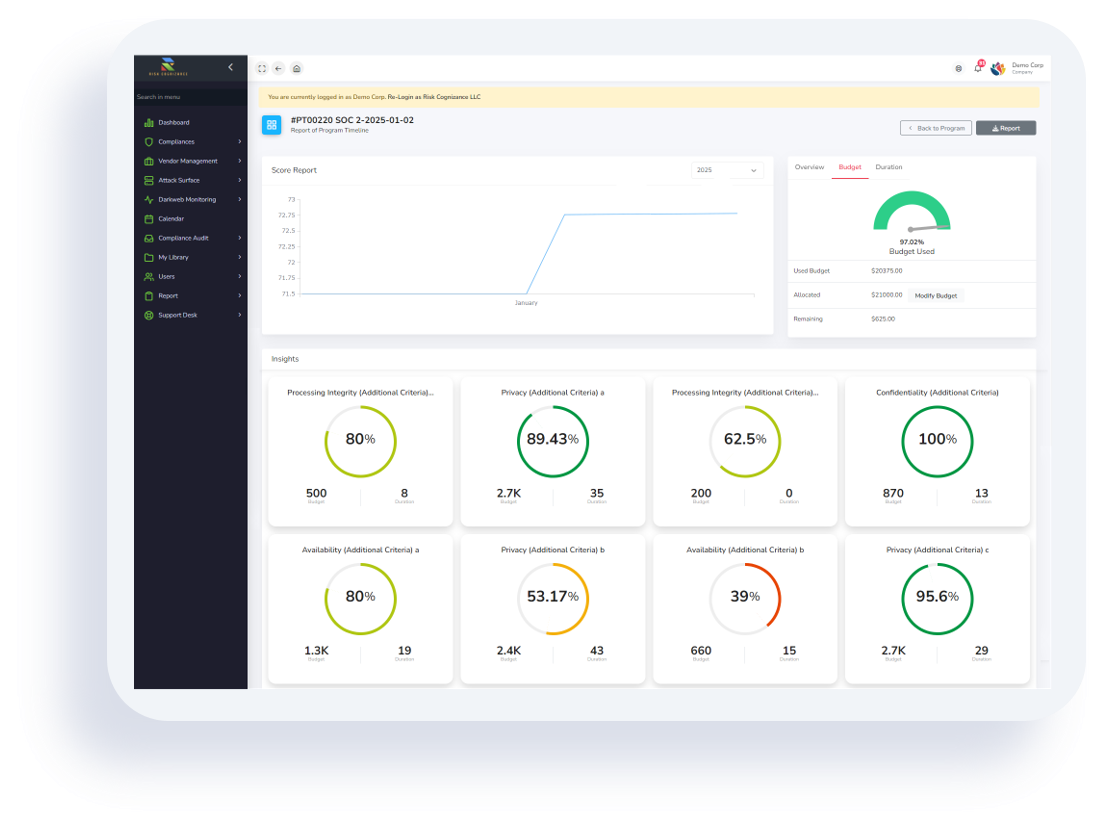
The Future of Artificial Intelligence: Navigating Business Innovation
AI can automate repetitive tasks and complex processes, optimize supply chains, and enable predictive maintenance, freeing up human resources for higher-value work.
AI-driven tools and LLMs can provide personalized customer interactions and deliver quick, insightful responses, leading to greater satisfaction and conversion rates.
AI excels at analyzing vast datasets to identify patterns, summarize complex documents, and make immediate, informed decisions faster than humans.
With AI handling routine design and engineering, companies can achieve an age of rapid innovation in product development and R&D.
Navigating Business Innovation with AI
Develop an AI Strategy:
Businesses need a clear, strategic vision aligned with their overall goals, encompassing data strategy, talent management, and a commitment to agility.
Invest in Talent:
Build a workforce with the skills to adapt to and drive AI innovation. This includes fostering a culture of continuous learning and creating diverse, psychologically safe teams.
Prioritize Data and Ethics:
Establish robust frameworks for data privacy, security, and responsible AI development to mitigate risks and ensure ethical deployment.
Foster Collaboration:
Encourage cross-functional collaboration between different teams, such as data scientists and marketers, to uncover new and creative applications for AI.
Embrace Agility and Experimentation:
Companies should foster creativity by allowing for experimentation and embracing agile approaches to adapt to the rapidly evolving AI landscape.
Conclusion
The shift from AI as a futuristic concept to a quiet utility is already happening. It’s no longer about speculation; it's about practical implementation and tangible results. At Risk Cognizance, our mission is to empower businesses to harness this power responsibly, transforming complex challenges in risk and compliance into opportunities for growth and resilience. We believe that by integrating intelligent, agentic systems into your core operations, you can build a smarter, safer, and more competitive future.

